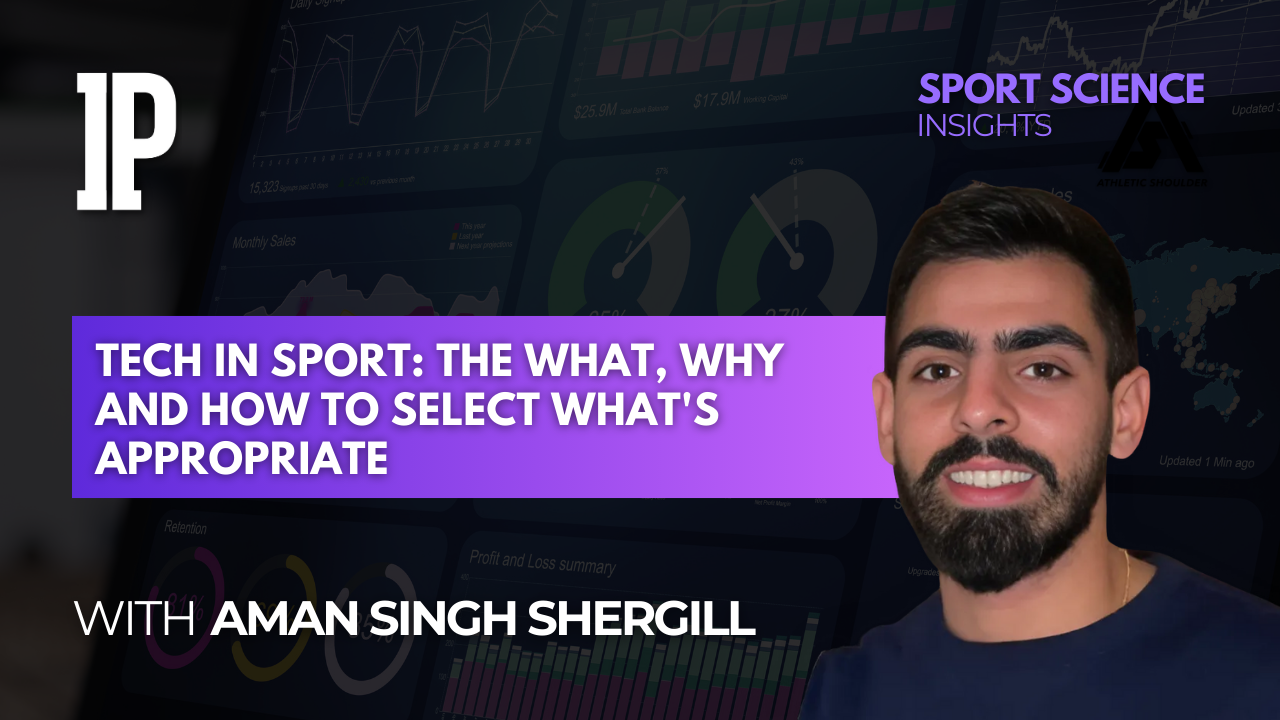Aman Singh Shergill - Tech in Sport: The What, Why and How to Select What's Appropriate
Mar 26, 2025
Episode 180: In this episode of our Sports Science Insights Podcast, powered by Inform Performance, host Steve Barrett speaks to Aman Singh Shergill, Head of Innovation and Performance Scientist for a Premier League & Champions League club. With a background in both applied and academic sport science, Aman is also completing his PhD at the University of Chester, making him a leading expert in technology-driven performance solutions.
Topics Discussed:
-
Aman’s journey into sport science and innovation
-
The evolution of sport science and its impact on elite performance
-
The role of technology in modern sport science practice
-
Are we using too much technology? – Finding the right balance
-
The 4 Pillars of implementation for effective tech use in sport
-
The future of technology in sports – Where are we headed?
Key Points
-
The exponential growth of data in football clubs has led to an increased focus on technology and data management. While this has expanded the possibilities for monitoring athletes, it has also created challenges in interpreting and utilizing the vast amount of information effectively. The abundance of data can sometimes obscure the overall picture of an athlete's readiness status, making it more complex to assess than in previous years.
-
The advancement of hardware technology, coupled with improvements in data science, machine learning, and AI, has significantly expanded the capabilities of sports science equipment. These developments allow for indirect measurements and algorithm-based calculations, enabling the measurement of a wide range of metrics. However, this abundance of measurable data doesn't necessarily translate to more informed decision-making or improved athlete performance.
-
The implementation of technology in sports science should be approached critically. Practitioners must question whether new technologies and measurements are truly helping to "push the needle forward" and inform decisions. The sheer volume of available technology can be overwhelming, and it's crucial to evaluate each tool's practical value in improving athlete performance rather than adopting technology for its own sake.
-
Athlete buy-in and education are crucial aspects of successfully implementing technology in sports science. Practitioners should involve athletes in the process, explaining the purpose, methods, and potential outcomes of various tests and measurements. This approach not only improves compliance but also capitalizes on the growing interest many young athletes have in personal health and performance data, mirroring trends in consumer wearable technology.
-
When introducing new technology or tests, a one-on-one, informal approach with athletes often proves most effective. This method allows practitioners to tailor their explanations to individual athletes' interests and personalities, fostering better engagement and understanding. While group presentations and video walkthroughs can be useful, personalized interactions tend to yield the best results in terms of athlete buy-in and comprehension.
-
The relationship between technology and athletes requires careful management. Practitioners should be prepared to justify the use of any technology or test if challenged by an athlete. This includes being able to explain how the data is used, its relevance to performance, and any actionable insights it provides. Transparency and clear communication are key to maintaining athlete trust and engagement with technological tools.
-
A structured approach to implementing new technology in sports science is essential. This process should involve a series of steps to evaluate the potential value and practicality of new tools. Without a clear protocol for assessing and implementing technology, organizations risk contributing to data confusion and overwhelming both practitioners and athletes with excessive, potentially irrelevant information.
-
The current challenges in sports science data management are often mischaracterized as purely data-related issues requiring more specialists or advanced skills. However, the root of the problem frequently lies in the overabundance of information without clear purposes or actionable insights. Practitioners should focus on developing a foundational understanding of data management as part of their core skill set.
-
When considering new technology, practitioners should follow a four-pronged approach to evaluation. This structured process helps ensure that any new tools or methods align with the organization's goals, can be effectively integrated into existing workflows, and provide meaningful insights that contribute to improved athlete performance or decision-making processes.
-
The evolving landscape of sports science technology necessitates a balance between embracing innovation and maintaining a focus on practical, actionable insights. While the capabilities of monitoring and analysis tools continue to expand, the ultimate goal remains to enhance athlete performance and inform coaching decisions. Practitioners must navigate this complex environment by critically evaluating new technologies and maintaining a clear connection between data collection and performance outcomes.
Where you can find Aman:
• ResearchGate
• X
Sponsors
VALD: makers of the Nordbord, Forceframe, ForeDecks and HumanTrak. VALD Performance systems are built with the high-performance practitioner in mind, translating traditionally lab-based technologies into engaging, quick, easy-to-use tools for daily testing, monitoring and training.
Hytro: The world’s leading Blood Flow Restriction (BFR) wearable, designed to accelerate recovery and maximise athletic potential using Hytro BFR for Professional Sport.
Teambuildr: A platform for any coach in any setting. Every day, thousands of coaches log into TeamBuildr to write training programs, build questionnaires and access athlete and client performance data. Teambuildr is a complete platform. Whether you're building your own programming, looking to create custom reports or give athletes a tool for accountability, they've built it out.




